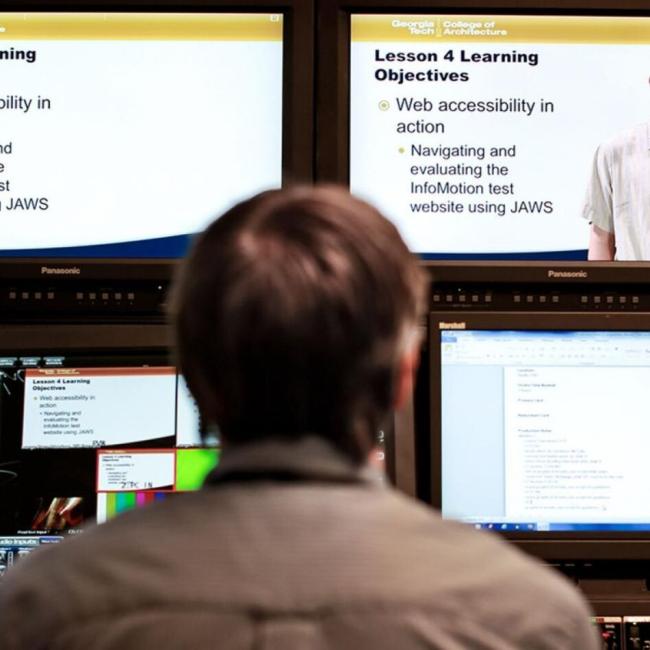Massive Open Online Courses
- Overview
- How MOOCs Work
Rapid expansion in technology has given learners worldwide access to Georgia Tech’s top-ranked programs and world-class faculty through free open online courses, or MOOCs. As a pioneer in online learning, Georgia Tech Professional Education (GTPE) offered its first MOOC in 2012. Since then, total MOOC enrollments have exceeded 3.3 million to date with more than 30 online courses offered in topics ranging from engineering to computing and ESL.
Unlike traditional courses that require you to be physically present in a university lecture hall, MOOCs are a self-paced and free online option, allowing you to be part of a virtual global network of faculty, peers, and industry experts from almost anywhere in the world.
All MOOCs are developed by GTPE’s Learning Design Team who understand the specific needs of adult learners in an online environment. The team – comprised of instructional designers, interactive media producers, graphic artists, editors, and simulation experts – partners with faculty to revamp in-class lectures into material suitable for highly engaging and effective online learning.
Offered through our provider platforms, MOOCs are available to anyone with an internet connection and are free to enroll. Some MOOCs can be started any time – others at regular intervals – and range in length from a few weeks to a few months to complete. You’ll have access to a wide range of online media and interactive tools, including video lectures, class exercises, discussions, and assessments.
Upon successful completion of some online courses, you can choose to receive a verified certificate for a small fee. We encourage you to share your Georgia Tech credentials on your resume, LinkedIn profile, or anywhere you wish to demonstrate your mastery of the subject.
OPEN ONLINE COURSE OFFERINGS
Businesses, consumers, and societies leave behind massive amounts of data as a by-product of their activities. Leading-edge companies in every industry are using analytics to replace intuition and guesswork in their decision making. As a result, managers are collecting and analyzing enormous…
View Course Details »Individuals with disabilities often encounter barriers in accessing electronic information and using digital technologies. In this course, you will learn about the fundamentals of accessibility design in the Information and Communication Technology (ICT) field. You will focus on…
View Course Details »This course explores the mathematical theory of two-player games without chance moves. You will cover simplifying games, determining when games are equivalent to numbers, and impartial games. Many of the examples of simple games may be new to you, such as Hackenbush, Nim, Push, Toads and…
View Course Details »Design is an essential part of providing a great user experience (UX), offering the user what they need in the most efficient and satisfying manner. This introductory course introduces the novice designer to a systematic and data-driven process cycle of discovery and evaluation, as well as a…
View Course Details »Analytical models are key to understanding data, generating predictions, and making business decisions. Without models, it is nearly impossible to gain insights from data. In modeling, it’s essential to understand how to choose the right data sets, algorithms, techniques, and formats to solve…
View Course Details »This course is your hands-on introduction to programming techniques relevant to data analysis and machine learning. Most of the programming exercises will be based on Python and SQL.
View Course Details »The field of health informatics emphasis the management and use of patient healthcare information. In this course, you’ll gain a brief overview of its history and capabilities, as well as an understanding of its slow adoption within organizations. You’ll be introduced to the Fast Healthcare…
View Course Details »As the exchange of health records and other clinical systems used in patient care become increasingly digital, the focus turns to how this health information can be communicated and shared throughout a patient’s health journey. While often a challenge, adopting health data standards in a…
View Course Details »Adopting digital health records and sharing its data is a critical step forward. In order to foster better collaboration across patient healthcare providers, cutting edge tools and systems must be used to improve the quality of patient care. This course will look at academic and industry…
View Course Details »Learn the principles of Human-Computer Interaction (HCI) to create intuitive, usable interfaces, with established design principles like feedback cycles, direct manipulation, affordances, signifiers, and more. In this course, you’ll take the first steps toward being a solid HCI practitioner…
View Course Details »Get into the user’s mind to understand the techniques for designing and evaluating user-centered systems that integrate with and influence the world around us. In order to expand the scope through which you view human-computer interaction, you’ll start by going further inside the user’s mind…
View Course Details »Build on your foundational knowledge of Human-Computer Interaction’s (HCI) core principles by learning to design interfaces in the real world. From the investigating user needs to brainstorming potential designs, creating prototypes, and evaluating those prototypes, you’ll learn the four-stage…
View Course Details »Complete your understanding of the design life cycle by learning to take interface ideas, prototype them quickly, and evaluate them with real users. In this final course in the professional certificate, you’ll complete your understanding of the design life cycle and learn about the modern…
View Course Details »Designing sound representations of information can be a complex, but a necessary part of engaging students and making material accessible to a larger group of learners. While advances in these tools (e.g. interactive simulations) have made interactive learning freely available to millions of…
View Course Details »This course starts from the beginning, covering the basics of how a computer interprets lines of code; how to write programs, evaluate their output, and revise the code itself; how to work with variables and their changing values; and how to use mathematical, Boolean, and relational operators…
View Course Details »Building on your prior knowledge of variables and operators, this course gets into the meat of programming. Organized into five chapters, this course starts by covering the fundamentals of what control structures are and what they do, then moves on to four common control structures in Python…
View Course Details »Build on your existing knowledge of conditionals, loops, and functions by studying more about complex Python data structures, including strings, lists, dictionaries, and file input and output. Organized into five chapters, this course starts by covering the basics of data structures, then…
View Course Details »Complete your introductory knowledge of computer science with this final course on objects and algorithms. Now that you've learned about complex control structures and data structures, learn to develop programs that more intuitively leverage your natural understanding of problems through…
View Course Details »This course provides an introduction to the Java programming language. It gives you a foundational overview and history of Java, and you’ll learn about the language’s basic syntax. At the end, you will be able to develop interactive console programs with basic data processing and formatting…
View Course Details »This course provides you with the knowledge to handle and even create exceptions to achieve graceful error handling in programs. You will also create and utilize data structures, including lists and files, while learning about recursion and how it can be a useful approach to repetition in a…
View Course Details »Build on the skills learned from “Introduction to Java Programming I: Foundations and Syntax Basics” and learn the basics of writing classes that serve as blueprints of concepts or objects that are represented in a programming problem. You will leverage the concepts of inheritance, interfaces,…
View Course Details »The Data Structures & Algorithms course begins with a review of some important Java techniques and nuances in programming. The course requires some prior knowledge of Java and object-oriented programming, but not in data structures or algorithms. You’ll be introduced to time complexity and…
View Course Details »This Data Structures & Algorithms course extends beyond linear data structures to the nonlinear and hierarchical data structures. The course begins by explaining Binary Trees and two subgroups: Binary Search Trees (BSTs) and Binary Heaps. You will program BSTs, their operations, and traversal…
View Course Details »This Data Structures & Algorithms course completes the data structures portion presented in the sequence of courses with self-balancing AVL and (2-4) trees. It also begins the algorithm portion in the sequence of courses as you will investigate and explore the two more complex data structures:…
View Course Details »This Data Structures & Algorithms course completes the four-course sequence of the program with graph algorithms, dynamic programming, and pattern matching solutions. A short Java review is presented on topics relevant to new data structures covered in this course and time complexity is…
View Course Details »Engineers are the ultimate problem solvers. This course introduces the principles required to solve engineering mechanics problems. It addresses the modeling and analysis of static equilibrium problems with an emphasis on real-world engineering applications and problem solving. To master…
View Course Details »Kinetics is the study of forces acting on these bodies and how it affects their motion. This course is an advanced study of bodies in motion as applied to engineering systems and structures. You will study the dynamics of rigid bodies in 3D motion, consisting of both the kinematics and…
View Course Details »The Applications in Engineering Mechanics course builds upon the principles you mastered in Introduction to Engineering Mechanics. Move beyond the fundamentals to learn modeling and analysis of static equilibrium problems. You will discover real-world engineering systems and problem-solving…
View Course Details »This course is an introduction to the study of bodies in motion, as applied to engineering systems and structures. You will study the dynamics of particle motion and bodies in rigid planar (2D) motion, which consists of both the kinematics and kinetics of motion. Kinematics deals with the…
View Course Details »This course expands on subjects covered in the Introduction to Engineering Mechanics and in Applications in Engineering Mechanics courses. Here, you will focus on axial loading and gain an understanding of what causes stress and strain on solid objects, which will help you problem solve and…
View Course Details »This course explores the analysis and design of thin-walled pressure vessels and engineering structures subjected to torsion. The course will look at real-world applications for thin-walled pressure vessels, such as gas storage tanks, simple spray cans, and techniques that could even be used…
View Course Details »Explore the analysis and design of beam bending problems in this third course in the Mechanics of Materials series.
View Course Details »This is the final course in the Mechanics of Materials series. Exploring the analysis and design of engineering structures, you will learn to consider factors of deflection, buckling, combined loading, and failure theories.
View Course Details »It is well recognized that the discovery of new materials is the key to solving many technological problems faced by industry and society. These problems include energy production and utilization, carbon capture, tissue engineering, and sustainable materials production, among many others. This…
View Course Details »This course provides a succinct overview of the emerging discipline of materials informatics at the intersection of materials science, computational science, and information science. You will discover specific opportunities afforded by this new field in accelerating materials development and…
View Course Details »The Introduction to Electronics course introduces you to the basic concepts of electronics, including diodes, transistors, and op amps. Basic operation and some common applications will also be discussed.
View Course Details »Have you ever wondered why ceramics are hard and brittle while metals tend to be soft and pliable? Or how about why some materials conduct heat or electricity while others are insulators? In this course, you will learn how a material’s properties are determined by the microstructure of the…
View Course Details »Machine Design Part I is the first course in an in-depth, three-course series focusing on machine design. The series covers fundamental mechanical design topics, such as static and fatigue failure theories, the analysis of shafts, fasteners, and gears, and the design of mechanical systems,…
View Course Details »A direct current (DC) source is one that is constant. In this course, you will learn how to analyze circuits that have DC or voltage sources, including circuits with resistors, capacitors, and inductors. Some practical applications in sensors will be demonstrated as well.
View Course Details »Analytical models are key to understanding data, generating predictions, and making business decisions. Without models, it is nearly impossible to gain insights from data. In modeling, it’s essential to understand how to choose the right data sets, algorithms, techniques, and formats to solve…
View Course Details »This course picks up with an overview of basic thermodynamics and kinetics as they pertain to the processing of crystalline materials. The first module deals with phase diagrams -- charts that tell us how a material will behave given a certain set of variables such as temperature,…
View Course Details »The Mechatronics Revolution is upon us. Never before has it been easier to build robotic devices and computer-controlled machines. The confluence of low-cost embedded computers, sensors, and actuators has made experimentation and prototyping easier than ever. Course modules will explore the…
View Course Details »At the beginning of this course we introduce the determinant, which yields two important concepts that you will use in this course. First, you will be able to apply an invertibility criterion for a square matrix that plays a pivotal role in, for example, the understanding of eigenvalues. You…
View Course Details »Systems of equations live at the heart of linear algebra. In this course you will explore fundamental concepts by exploring definitions and theorems that give a basis for this subject. At the start of this course we introduce systems of linear equations and a systematic method for solving them…
View Course Details »Your ability to apply the concepts that we introduced in our previous course is enhanced when you can perform algebraic operations with matrices. At the start of this class, you will see how we can apply the Invertible Matrix Theorem to describe how a square matrix might be used to solve…
View Course Details »In the first part of this course you will explore methods to compute an approximate solution to an inconsistent system of equations that have no solutions. Our overall approach is to center our algorithms on the concept of distance. To this end, you will first tackle the ideas of distance and…
View Course Details »This course provides an introduction to basic probability concepts. Our emphasis is on applications in science and engineering, with the goal of enhancing modeling and analysis skills for a variety of real-world problems. In order to make the course completely self-contained (and to bring…
View Course Details »This course provides an introduction to basic statistical concepts. We begin by walking through a library of probability distributions, where we motivate their uses and go over their fundamental properties. These distributions include such important folks as the Bernoulli, binomial,…
View Course Details »This course covers two important methodologies in statistics – confidence intervals and hypothesis testing. Confidence intervals are encountered in everyday life, and allow us to make probabilistic statements such as: “Based on the sample of observations we conducted, we are 95% sure that…
View Course Details »This course discusses properties and applications of random variables. When you’re done, you’ll have enough firepower to undertake a wide variety of modeling and analysis problems; and you’ll be well-prepared for the upcoming statistics courses. We’ll begin by introducing the concepts of…
View Course Details »This course is an introduction to exploring the topic of engineering systems undergoing vibration. The methods taught in the course are used to predict the response of engineering structures to various types of input and to analyze the resulting vibratory motion. The free vibration of Single…
View Course Details »Brush up on your engineering fundamentals! Prepare for the Fundamentals of Engineering (FE) exam by reviewing the seven major knowledge areas that it covers, with emphasis on civil-engineering subjects. The FE exam is now a computer-based test that is offered year-round.
View Course Details »In the 21st century, there are millions of innovators but few authentic innovation leaders able to inspire and guide innovators and their teams to create breakthrough products with their innovative ideas. In this original course, Innovation Leadership, you'll learn how to become an innovation…
View Course Details »At the beginning of this course we introduce the determinant, which yields two important concepts that you will use in this course. First, you will be able to apply an invertibility criterion for a square matrix that plays a pivotal role in, for example, the understanding of eigenvalues. You…
View Course Details »Systems of equations live at the heart of linear algebra. In this course you will explore fundamental concepts by exploring definitions and theorems that give a basis for this subject. At the start of this course we introduce systems of linear equations and a systematic method for solving them…
View Course Details »Your ability to apply the concepts that we introduced in our previous course is enhanced when you can perform algebraic operations with matrices. At the start of this class, you will see how we can apply the Invertible Matrix Theorem to describe how a square matrix might be used to solve…
View Course Details »In the first part of this course you will explore methods to compute an approximate solution to an inconsistent system of equations that have no solutions. Our overall approach is to center our algorithms on the concept of distance. To this end, you will first tackle the ideas of distance and…
View Course Details »This course provides an introduction to basic probability concepts. Our emphasis is on applications in science and engineering, with the goal of enhancing modeling and analysis skills for a variety of real-world problems. In order to make the course completely self-contained (and to bring…
View Course Details »This course provides an introduction to basic statistical concepts. We begin by walking through a library of probability distributions, where we motivate their uses and go over their fundamental properties. These distributions include such important folks as the Bernoulli, binomial,…
View Course Details »This course covers two important methodologies in statistics – confidence intervals and hypothesis testing. Confidence intervals are encountered in everyday life, and allow us to make probabilistic statements such as: “Based on the sample of observations we conducted, we are 95% sure that…
View Course Details »This course discusses properties and applications of random variables. When you’re done, you’ll have enough firepower to undertake a wide variety of modeling and analysis problems; and you’ll be well-prepared for the upcoming statistics courses. We’ll begin by introducing the concepts of…
View Course Details »Looking to gain a solid understanding of what a supply chain is all about? This course provides a great introduction to the integrated supply chain model. You will have the chance to leverage discussions, videos, and quizzes to expand your foundational knowledge on the subject and find out…
View Course Details »In the first part of this course you will explore methods to compute an approximate solution to an inconsistent system of equations that have no solutions. Our overall approach is to center our algorithms on the concept of distance. To this end, you will first tackle the ideas of distance and…
View Course Details »Analytics: Essential Tools and Methods MicroMasters
Take three introductory Georgia Tech courses in analytics to earn a MicroMasters credential from edX. Learn fundamental, in-demand analytics skills to maximize business impact and advance your career as an analyst.
MOOC PROVIDERS
Coursera and edX currently offer Georgia Tech courses in a massive open online environment. To enroll, please browse the available courses through one of the MOOC providers below.


MOOC Frequently Asked Questions
Designed for an online audience, MOOCs are available to anyone with an internet connection and are free to enroll. Some MOOCs can be started any time – others at regular intervals – and range in length from a few weeks to a few months to complete. You’ll have access to a wide range of online media and interactive tools, including video lectures, class exercises, discussions, and assessments.
Anyone with an internet connection can enroll. Some courses may be unavailable in a small number of countries because of trade restrictions or government policies.
Most courses are free, though there is a small fee if you opt to work towards a certificate of completion. Some courses count toward university credit—and some, like our online master’s program in computer science, offer a full degree. These credit-bearing courses do have fees and applications associated with them.
Yes, Georgia Tech offers CEUs for some completed MOOC courses taken through Coursera and edX. You have the option of purchasing CEUs after earning a verified course certificate.
A digital badge is an acknowledgement that you've successfully completed a MOOC course. You can display your digital badge on your online profiles so that colleagues and employers can see your achievements at a glance.
You can earn CEUs, digital badges, and verified certificates of completion. You can also use MOOCs as an alternate pathway to enter Georgia Tech master's programs through The Analytics: Essential Tools and Methods MicroMasters and the Online Master's in Computer Science.
Certificates of completion are issued by the online provider, Coursera or edX. Although they are a great way to showcase your skills, they are not the same as official academic credit from Georgia Tech. However, if you purchase CEUs (which are denoted by a badge), then you can request an official GTPE transcript for free.
MOOC NEWS


